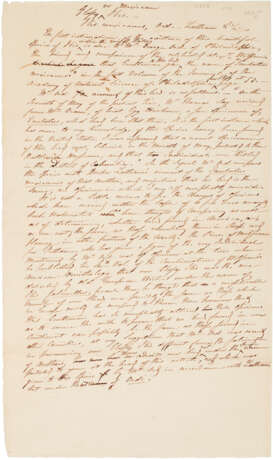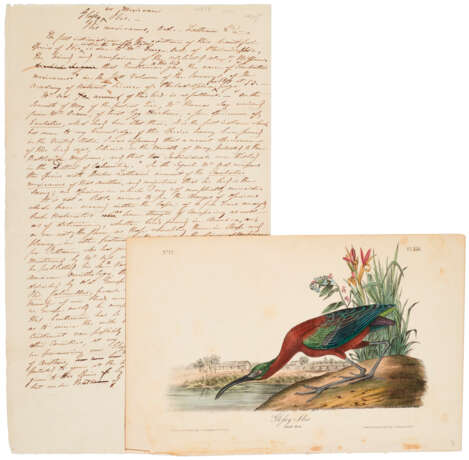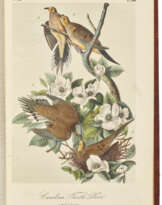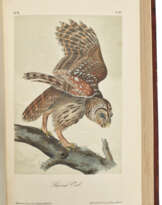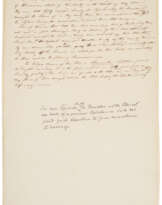ID 1236382
Лот 151 | Glossy Ibis
Оценочная стоимость
$ 8 000 – 12 000
One page, folio, wove paper, 339 x 199mm (minor edgewear, horizontal folds). Accompanied by a hand-colored lithographed plate of Glossy Ibis extracted from an octavo edition. Blue cloth chemise, custom clamshell.
Audubon's original manuscript description of the Glossy Ibis, plate 387 of the Birds of America, with an interesting digression on identity questions of European and American birds with similar morphologies. To accompany his ambitious elephant folio edition of the Birds, Audubon published the Ornithological Biography with the editorial assistance of William Macgillivray (1796-1852). Although text and plates were planned together, British copyright law compelled Audubon to publish the volumes under a separate title or else he would have had to deposit full sets of the enormously expensive plates to all nine depository libraries within the United Kingdom. In other records, Audubon stated that he saw the Glossy Ibis only once and in Florida, which he visited in 1831 and 1832. However his painting of it is on paper watermarked 1836; perhaps it was copied later. See Low, A Guide to Audubon’s Birds of America.
Transcribed in full: “The first intimation of the existence of this beautiful species of Ibis ^ within the United States ^ is due to Mr. George Ord of Philadelphia, the friend and companion of the celebrated Alexr. Wilson. That Gentleman gave ^ to this bird ^ the name of ‘Tantalus Mexicanus’ in the first volume of the Journal of the Academy of Natural Sciences of Philadelphia ^ for 1817 at ^ page 53.
“Mr. Ord’s account of this bird is as follows: ‘on the seventh of May of the present year, Mr. Thomas Say received from Mr. Oram, of Great Egg Harbour, a fine specimen of Tantalus, which had been shot there. It is the first instance which has come to my knowledge of this species having been found in the United States. I was informed that a recent specimen of this bird was, likewise in the month of May, presented to the Baltimore Museum, and that two individuals were killed in the District of Columbia.' In the sequel Mr. Ord compares this species with Dr. Latham's account of the Tantalus Mexicanus of that author, and conjectures that his bird is the same; an opinion in which I myself completely coincide.
“It is not a little curious to see the changes of opinion which have occurred within the lapse of a few years among naturalists as have thought of comparing as well as of determining, whether birds found in America are, or are not, the same as those resembling them in shape and plumage in other parts of the World. The Prince of Musignano, for instance, who has given a figure of the very individual mentioned by Mr. Ord, was of opinion at the time when he published the fourth volume of his continuation of Wilson’s American Ornithology, that our Glossy Ibis was the one described by the old European writers under the name of Ibis Falcinellus, because then he thought that a considerable number of our Birds were precisely[?] the same as those which in Europe could be compared to these. Now, however, that this gentleman has so completely altered his opinions, as to evince the wish to prove that no bird found in our continent can possibly be the same as those found in other countries; at my suggestion that Mr. Ord was correct in pronouncing our Glossy Ibis different from the Falcinellus of Authors, has now has now admits our bird not under the specific name presented to you at the head of this article, and was given to this species by Mr. Ord in accordance with Latham, but under that of Ordi.”
The manuscripts differs in several places from the published text, which also continues with a description of the bird’s habitat and a telling concluding sentence to the above paragraph: “This new name I cannot with any degree of propriety adopt. I consider it no compliment to the discoverer of a bird to reject the name which he has given it, even for the purpose of calling it after himself.” The bird is still known today as the Glossy Ibis and it is the same as the (migratory) species as found in Europe, as well as South America, Africa, Asia and Australia—it is the most widespread of the ibis species.
| Автор: | Джон Джеймс Одюбон (1785 - 1851) |
|---|---|
| Место происхождения: | США |
| Категория аукционного дома: | Письма, документы и рукописи |
| Автор: | Джон Джеймс Одюбон (1785 - 1851) |
|---|---|
| Место происхождения: | США |
| Категория аукционного дома: | Письма, документы и рукописи |
| Адрес торгов |
CHRISTIE'S 8 King Street, St. James's SW1Y 6QT London Великобритания | |
|---|---|---|
| Предосмотр |
| |
| Телефон | +44 (0)20 7839 9060 | |
| Комиссия | see on Website | |
| Условия использования | Условия использования |
